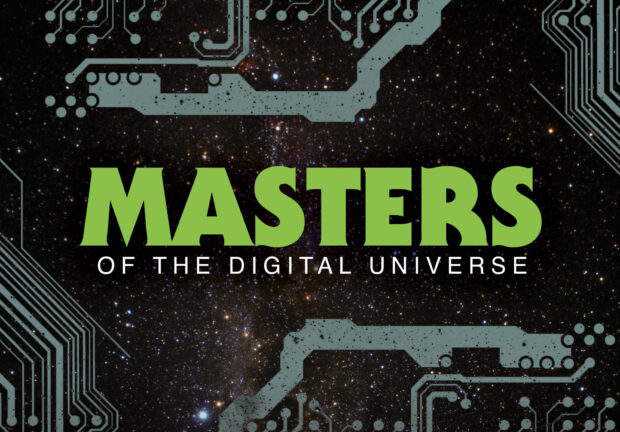HOME | ABOUT US | MEDIA KIT | CONTACT US | INQUIRE
HOME | ABOUT US | MEDIA KIT | CONTACT US | INQUIRE

Maybe you run a pizzeria or a shoe store, or you’re an executive with a grocery chain or a hardware store. Maybe you’re the office manager for a law firm, pharmacy or an accounting firm. Your goal in business is to move pizzas, or sell shoes, cabbage or tools, help a client with a legal matter, fill a prescription or handle someone’s tax return.
What you probably don’t want to do is hassle with information technology. The conundrum, of course, is that you need the IT tools to run your business as efficiently as possible. But who has time to be fully informed on what’s going on with IT today and still get the to-do list to-done? Wouldn’t it be nice if you could consult with some of the sharpest minds on Kansas City’s IT scene today and pick their brains about how the changing world of information can—will—impact your business?
No need to: We’ve done it for you. Ingram’s queried business executives in the region to find out whom they consider the best of the best in IT. From their responses, we chose a field of experts in executive roles as chief information or chief technology officers: Jeff Shipley of Blue Cross and Blue Shield of Kansas City in health care, Calep Howard of MMGY Global in digital marketing, Dan Bentzinger of MIQ Logistics and Byron Clymer of Freightquote in transportation logistics, and Scott Thompson of Tricension, who advises other businesses on their IT needs.
They offered keen insights into how IT is changing—and how fast—how businesses should set or refine their IT strategies, how mobility is reshaping the IT world, and more. We’re confident that their answers will prove as illuminating for you as they did for us.
Priority One is “having a platform that allows your team to pivot with the needs of your business or industry,” said Byron Clymer. “Small companies are fighting daily to stay relevant, to stay ahead … The biggest challenge is choosing technology that optimizes your ability to pivot.
Freightquote has a small IT budget, so the technology choices we make have to give us the most flexibility to
pivot quickly.”
Calep Howard sees a challenge for everyone in how to leverage what cloud computing offers to drive IT costs down and reliability up—while not leaving users behind. “Consider the life cycle of a traditional file server,” he says. “As operating systems are updated and hardware ages, we all have to make decisions about when we replace this workhorse machine. The challenge is deciding when we no longer need to replace the physical hardware but rather move to a service that solves the same business problem.”
Moving from a physical to a cloud-based server, he says, will require changes in how companies have traditionally managed their infrastructure, by moving the hardware out of the organization and paying only for the storage and bandwidth to get there will ultimately take complexity out of the back office. “Bandwidth and storage are under increasing competitive pressure,” he notes, “so costs of these commodities will continue to decline.”
It’s important, though, said Dan Bentzinger to recognize the limitations of cloud usage. “The cloud vendors want us to all think we can rent everything and our problems go away,” he said. But, he cautioned, “as IT leaders, we still must own the budgets, data, and process. Integration and governance are always of central importance.
Even though a service may be ‘in the cloud,’ we are still responsible.”
The biggest mistake any executive can make in laying out an IT strategy, said Jeff Shipley, is creating a strategy outside of what the business is really all about. “It’s a complete mistake, and we’ve made that a couple times,” he confesses. It comes, he said, from having too narrow a focus in thinking about IT needs. Maybe technology can help cut staffing costs, he said, but that can go too far: “That may have a negative impact on business customers and external customers,” Shipley said. “You need to understand the needs of customers before laying out that strategy; you can’t do it in isolation.”
Scott Thompson, too, sees cloud computing as the biggest challenge, mainly because it’s still a maturing field. “That said, the industry is maturing at an incredible rate and has the potential to provide enormous benefits to smaller firms in particular,” Thomson said. “I believe Microsoft is rolling out new changes to its Azure platform every two weeks. The main issues revolve around which platform to choose.” With a niche providers, he said, you run the risk of them succumbing to the competitive landscape; established providers will come at premium prices, and likely will offer more complex systems that can become challenging to maintain.
“The one thing I know for sure,” Thompson said, “is that organizations should be moving in the direction of cloud computing sooner rather than later, involving multiple providers, if possible, to mitigate risk until the industry is fully matured.”
So what is the single biggest mistake a business owner or executive makes in framing an information-systems strategy?
“Business and technology leaders in too many organizations think their business is fundamentally different from every other business sector,” said Calep Howard. That, he said, “leads organizations to believe they need to build their own proprietary systems instead of looking to the market for commercially-available technology that can be adapted to support their business.” By ignoring the market, businesses can over-invest in home-built technology, creating a bottom-line squeeze. “My advice is to go to market looking for commonalities between industries and then researching technologies that support those common functions or processes,” Howard said. “A software license agreement and annual maintenance is likely a more cost-effective way to support those functions or processes that are not strategic differentiators for your organization.”
Setting an effective strategy means conducting thorough analysis up front, said Thompson. “I can’t tell you how many times I’ve seen companies purchase a piece of software only to have it sit on the self or be implemented incorrectly, to the point where it causes more business problems than it solves,” he said. A point of pride for his company, he said, “is the fact that we are business people first and technologists second. It may seem obvious, but it is critical to understand what problem you are trying to solve and then find the best technology solution to fit that need.”
Byron Clymer identified three common strategic mistakes. First, he said, is not looking at the full range of computing, storage and networking aspects. “I am a big fan of commoditized hardware,” he said. “Don’t build software for a specific version of OS; the OS will be outdated in a few years. It may look cool or run fast now, but it will limit your ability to pivot. He also says executives should expect change, and bake agility into their plans. Finally, “the strategy should have clear value to your company,” Clymer said. “Not because it’s cool technology, but because it will enable something.”
But the biggest mistake, said Dan Bentzinger, is simply not having a strategy. “IT strategy cannot be an after-thought,” he says. “In many ways, it also cannot be done after the business strategy is complete. IT needs to take a leadership position and help drive the business.”
If you had to pick one aspect of IT/information systems operations that most businesses could correct with
minimal investment, what would it be?
“Nothing,” Dan Bentzinger declares, “is more important than alignment.” The CIO needs to be humble and confident—a tough balance, he said. “Your idea will move faster if you convince enough other people it was their idea in the first place.” That requires patience, because “you simply cannot force your thoughts upon the operational teams. A team approach may require some extra steps. It may feel slower, however the result will always be better.”
For Byron Clymer, the key is integrating your IT staffers with the whole business. “Everyone in your IT organization should understand your business,” he said. “Require yourself and the rest of your IT staff to sit with an employee and watch how they use the systems IT built.”
Unless your business process is completely unique, said Calep Howard, the chances are that there are already tools available to help meet day-to-day operations needs. “My organization always starts out by defining what needs to be done before we can determine how to solve the problem,” he said. “By separating What from How, organizations may find that they can adjust their work flow to allow them to use a commercially available product that will have a lower total cost of ownership than a home-built system.”
Customer relationship management, said Scott Thompson, tends to be the quickest solution to implement with the most far-reaching impact to an organization’s bottom line. “Given the number of affordable cloud offerings in the CRM space,” he said, “it is not uncommon for us to establish an automated sales and marketing processes in 30-60 days.
With respect to the rapidity of technological change for both hardware and software, how quickly is that pace changing?
“That’s a whole ’nother conversation about pace of change, especially in health care and insurance,” said Jeff Shipley, who’s been with Blue Cross for 19 years. “It is unlike anything I could ever have imagined over the past two or three years.” Still he says, the changes he sees most entail minor deviations from technologies in use for some time, largely because the innovators of the world—Apple, IBM, Microsoft— are all copying off each other. “The change that I see coming very rapidly is that we traditionally have always tried to do everything ourselves—control it and keep it within our four walls. But the last three years, we’ve relied heavily on partnerships with software vendors, SAAS and cloud integrations. Because of the pace of change and speed-to-market demands, we can’t build it all and control it all any more.”
Dan Bentzinger said he’s watched the race between software and hardware for his whole career. “As the hardware has improved, we quickly created software that more than consumed that capacity,” he said. “Today, I tend to worry less about hardware. With the movement towards cloud services, we are buying CPU cycles and racking up fewer physical boxes. More and more, hardware is a virtual entity for most of us.”
The speed of that change, said Byron Clymer, can’t be quantified, but it is nonetheless accelerating. “Software is accelerating faster than hardware, although I am excited to see advancements made in quantum and photonic computing, these technologies are a ways out for commercial use,” he said. “Today’s world rides on the axles of software programs. I am amazed at what today’s software engineers are capable of creating.
The limits of a software engineer go as far as their imagination. Languages, algorithms and techniques of software engineers are advancing every day. Programming or logical processing is finding its way into new fields and exposing itself to new individuals who are starting to engineer their own software.”
But programming, he noted, is like building with Lego blocks: “Do you go for the set and follow the instructions or do you take a random pile of blocks and create something unique? More and more people are doing the latter, and creating some really cool stuff.”
Calep Howard sees technology at an interesting point in the lifecycle of hardware and software for the end user “and we’re at this point because of the pace of change,” he said. “For all but the most specialized … we can stop buying powerful computers and more local and network storage. Cloud technology has evolved to the point where a device as inexpensive as a Chromebook and a Google Apps or Microsoft 365 account can support a user very effectively.”
The challenge for IT professionals, he said, is that without thoughtful configuration and robust end-user training and support, moving to cloud-based end user computing will be a significant disruption to how we have all used technology to do our jobs. “We’ve been using the local network environment for years, and our entire corporate computing infrastructure is built to support end users working locally or on the local network,” Howard said. “To make the move to the cloud, we’ll need to re-think everything to avoid disruption and ensure our end-users can make the transition easily and efficiently.”
The change, Shipley noted, isn’t just with the technology; it’s with the very players who drive the changes. Aetna, he pointed out, recently acquired a tech company that Blue Cross had pondered acquiring as well. Now those services belong to a competitor: “There’s a tremendous amount of acquisition in the health-care space, particularly around tech specialization.”
As legacy computing and networking systems die out, said Scott Thompson, “we are continually preaching development patterns such as services-oriented architecture (SOA) to help businesses embrace the notion that the one consistency in IT is change. By doing so, you’ve empowered the business to take a plug-and-play attitude with the next “big thing” and allow them to keep pace as much as possible.”
What additional complexities has mobility brought to your duties and those of IT directors generally?
“Mobility has no doubt changed the landscape of IT,” said Scott Thompson. “Gone are the days of building Web applications for the desktop alone. Anymore, our clients just assume that anything we build is mobile accessible, which typically means constructing responsive sites that provide the proper user experience to fit the form factor of each device.”
Mobile is obviously huge, said Dan Bentzinger. “A large majority of the screens we view and use are now Post-it note-sized. Apps need to be responsive to the nature of the network and the dynamic size of the interface. The top tools and languages for these interfaces did not exist a short time ago. So, we have to continue learning and evolving our thinking.”
“Mobility is more than just having a mobile app,” said Byron Clymer. “You have to create an awesome experience around it. We are looking for features and products in our business that makes sense to expose to the user on the small screen. We will use mobile to augment the experience for employees and our customers.”
The challenges of mobility, said Calep Howard, lie not as much about the presentation layer, “but rather in how we architect our technology solutions to support as many delivery channels as possible.” The mantra for his technology team, he said, is “give me an end point and I can program to it.” “When the endpoints do not exist, that’s when we need to take a step back and build that data delivery layer that allows us to consume and present the data through a number of different interfaces—whether that be a responsive Web site, a mobile app, or a traditional desktop data-driven application.” Nearly 40 percent of all travelers carry three devices, he said, which highlights the increasing importance of supporting multiple formats.
But mobility does offer benefits unimagined in the past, Jeff Shipley said, recalling the Snowmageddon of last Feb. 3. “The CEO called at 3:30 p.m. on Monday and said, ‘Jeff, there’s a big storm coming that’s going to shut this city down. I’m going to send out a note to our 1,100 employees that we are shutting our doors, but that they’re expected to do their job from home. I said we’ve never done that before, and he said, ‘I know: Make it happen.’ But his team responded, issued instructions to the staff, implemented the correct security tokens, and by 9 a.m. the next day, had 95 percent of the Blue Cross work force conducting business as usual—from the security of their own homes.
A happy unintended consequence of that is that Blue Cross was able to put on the market an empty building it was holding in reserve as an emergency-operations center, if it ever needed one. And it proved, Shipley said. “that we’re not just wire-lickers, we bring great value to a business.”
 Dan Bentzinger, MIQ Logistics
Dan Bentzinger, MIQ Logistics
Chief Information Officer
His path to IT: A Nebraska native, he dabbled in mechanical engineering before finding his way into the engineering lab. “I studied mechanical engineering and discovered that the cycle time from concept to result was far too long. I gravitated to the computer in the engineering lab and discovered that IT solutions could be imagined and built much faster. It was a natural extension of engineering. Speed is everything and I like to go fast.”
 Byron Clymer, Freightquote
Byron Clymer, Freightquote
Chief Information Officer
His path to IT: “I took the long road to get my IT career moving; I went to undergrad to be a physicist. Physics had a heavy reliance on computers. I had already taught myself how to program and was a weekend hacker of sorts. When I started coding for my lab work, that made me realize computer science is what I wanted to do. I finished out my bachelor’s degree in physics (Nebraska Wesleyan) and went on to grad school in computer science (Nebraska-Lincoln).”
 Calep Howard, MMGY Worldwide
Calep Howard, MMGY Worldwide
Chief Technology Officer
His path to IT: It was a short one—he was a computer science major at UMKC. He stuck with it, he says, because he had the right mentors (including a professor, George Gale); relationships that were fundamental to every career move; and tenacity: “It is easy to start projects but much harder to fin-ish them. … Building a reputation as someone who can get things done will mean the most in the job market.”
 Jeff Shipley, Blue Cross Blue Shield of Kansas City
Jeff Shipley, Blue Cross Blue Shield of Kansas City
Vice President/Chief Information Officer
His path to IT: Well, it was unpredictable. A degree in math and actuarial science was followed up by . . . running a cattle ranch. Then in graphic design, printing T-shirts, then selling mortgages for TransAmerica. He moved into IT as a programmer for Missouri’s Department of Health, forging the link to Blue Cross. “It doesn’t matter what degree you have,” Shipley says, “use every experience you have, and learn from it.
Even from the ranch, I learned valuable lessons I still use today.”
 Scott Thompson, Tricension
Scott Thompson, Tricension
Chief Technology Officer
His path to IT: “My fascination with computers started at a very young age,” he said, sparked by an Apple IIe that his father, a junior high principal, brought home from school. “I taught myself how to program in Basic, writing games or generating simple graphics on the green screen. Programming always came natural to me. As the years past and the computing power became more advanced, my interest only grew stronger and my career in IT was pretty well set.”